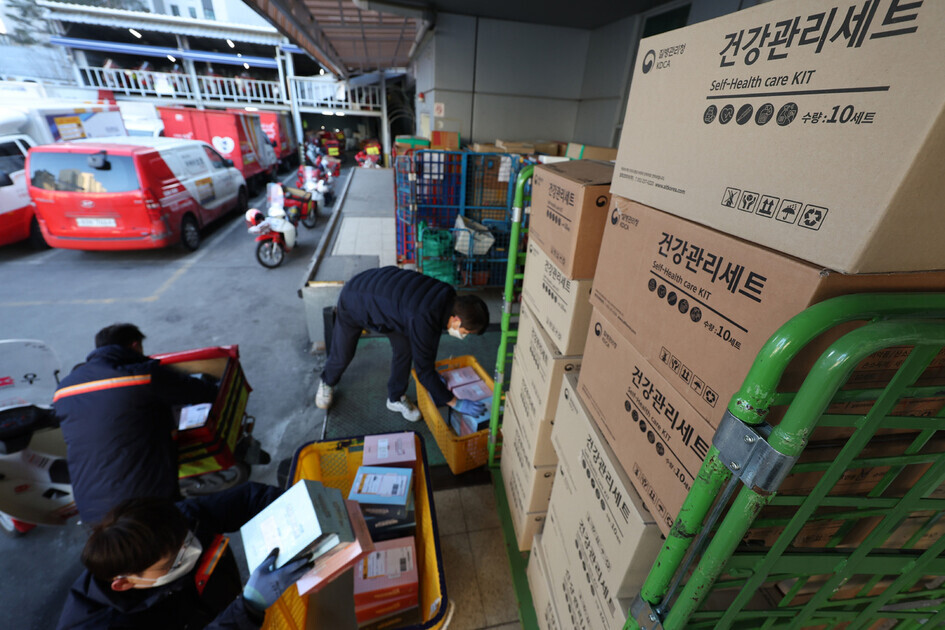hankyoreh
Links to other country sites 다른 나라 사이트 링크
Current COVID-19 wave represents first step out of pandemic, S. Korean officials say

The South Korean government believes the current surge of the Omicron variant of the coronavirus is the first step toward COVID-19 becoming an endemic disease in the country. While the daily caseload has surged above 110,000, the government said it may move to restore everyday routines as long as indicators such as the number of severe and critical cases hold steady.
“As we continue to monitor the risk of Omicron, we are currently in the initial stage of transitioning to the approach of managing [COVID-19] as an endemic disease,” said Park Hyang, who oversees disease control at Korea’s Central Disaster Management Headquarters, in a daily press briefing Tuesday.
“If we can keep the pandemic under control and the case fatality rate low in the future, we’ll ultimately be able to start treating Omicron like any other infectious disease. We still have a long way to go, but we’ve basically reached the point where we can start looking for an exit,” Park said.
“In the short term, the Omicron wave is a crisis, but in the mid- and long term, it’s an essential phase we must pass through in order to return to normal. If we can navigate this outbreak while preserving our health care system and minimizing severe disease and death, it will be an opportunity to go back to normal life,” she added.
Omicron has a severe case incidence of 0.38% and a case fatality rate of 0.18%, both one-quarter of the rates for Delta (1.4% and 0.7%, respectively). As Omicron has replaced Delta, the cumulative case fatality rate declined from 0.78% in the first week of January to 0.48% in the second week.

Korea’s disease control authorities explained that shifting from suppressing the pandemic to managing it is part of a transition to living with COVID.
“We’re entering the stage of transitioning to the approach of living with COVID-19 while taking appropriate steps to manage patients who have a high risk of developing serious conditions,” said Son Young-rae, who oversees social strategy for the Central Disaster Management Headquarters.
Son explained that the time frame for returning to normal routines would be decided “through a comprehensive assessment of these circumstances in the pandemic moving forward, whether cases began to decline after reaching a peak, trends in severe and critical cases and deaths at that time, and the resources of our healthcare system.”
The details of Korea’s return to normal are likely to be tailored to the characteristics of the Omicron variant.
“The plan to restore normal routines that we announced last November was based on the severe case incidence and case fatality rate of the Delta variant. We don’t believe we can use those exact figures,” Son said.
“We need to lower the risk in some areas and speed up the return to normal in other areas. We’ll need to go over those areas and adjust them once more.”
These comments come as Korea’s COVID-19 caseload has exceeded 150,000 for the first time.
Yonhap News reported that as of 9 pm on Tuesday, disease control officials and local governments around the country had reported 158,005 new cases of COVID-19. There had been 113,323 new cases as of 6 pm, but 44,682 more cases poured in over the next three hours.
As of Wednesday morning, the Ministry of Health and Welfare had announced 171,452 new confirmed cases of COVID-19 in the country.
The Korean authorities announced Tuesday that 99,573 new cases of COVID-19 had been reported Monday, up 4,234 from the day before. There were 480 patients hospitalized with serious or critical cases of the disease, the fourth day in a row that serious cases were in the 400-499 range.
COVID-19 intensive care units were at 36.4% capacity as of 5 pm on Tuesday, with 1,701 hospital beds available for use.
By Park June-yong and Lim Jae-hee, staff reporters
Please direct questions or comments to [english@hani.co.kr]

Editorial・opinion
![[Column] The state is back — but is it in business? [Column] The state is back — but is it in business?](https://flexible.img.hani.co.kr/flexible/normal/500/300/imgdb/original/2024/0506/8217149564092725.jpg) [Column] The state is back — but is it in business?
[Column] The state is back — but is it in business?![[Column] Life on our Trisolaris [Column] Life on our Trisolaris](https://flexible.img.hani.co.kr/flexible/normal/500/300/imgdb/original/2024/0505/4817148682278544.jpg) [Column] Life on our Trisolaris
[Column] Life on our Trisolaris- [Editorial] Penalties for airing allegations against Korea’s first lady endanger free press
- [Editorial] Yoon must halt procurement of SM-3 interceptor missiles
- [Guest essay] Maybe Korea’s rapid population decline is an opportunity, not a crisis
- [Column] Can Yoon steer diplomacy with Russia, China back on track?
- [Column] Season 2 of special prosecutor probe may be coming to Korea soon
- [Column] Park Geun-hye déjà vu in Yoon Suk-yeol
- [Editorial] New weight of N. Korea’s nuclear threats makes dialogue all the more urgent
- [Guest essay] The real reason Korea’s new right wants to dub Rhee a founding father
Most viewed articles
- 1[Column] Why Korea’s hard right is fated to lose
- 260% of young Koreans see no need to have kids after marriage
- 3Amid US-China clash, Korea must remember its failures in the 19th century, advises scholar
- 4[Column] The state is back — but is it in business?
- 5Japan says it’s not pressuring Naver to sell Line, but Korean insiders say otherwise
- 6AI is catching up with humans at a ‘shocking’ rate
- 7S. Korean chaebols comprise 84% of GDP but only 10% of jobs
- 8Hybe-Ador dispute shines light on pervasive issues behind K-pop’s tidy facade
- 9[Column] Life on our Trisolaris
- 10[Reportage] New funeral culture taking hold in South Korea